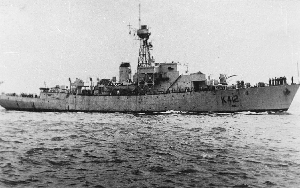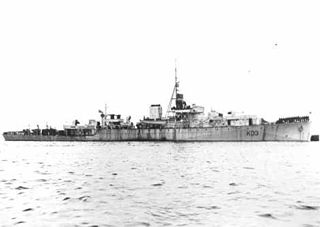
The Flower-class corvette was a British class of 294 corvettes used during World War II, specifically with the Allied navies as anti-submarine convoy escorts during the Battle of the Atlantic. Royal Navy ships of this class were named after flowers, hence the name of the class.

HMS Bamborough Castle was one of 44 Castle-class corvettes built for the Royal Navy during World War II. Completed in mid-1944 she sank the U-boat U-387 on 9 December. Aside from a brief period assigned to the Fishery Protection Squadron in 1946, the rest of her career was spent as part of the fleet reserve until she was scrapped in May 1959.

The River class was a class of 151 frigates launched between 1941 and 1944 for use as anti-submarine convoy escorts in the North Atlantic. The majority served with the Royal Navy (RN) and Royal Canadian Navy (RCN), with some serving in the other Allied navies: the Royal Australian Navy (RAN), the Free French Navy (FFN), the Royal Netherlands Navy and, post-war, the South African Navy (SAN).

A depot ship is an auxiliary ship used as a mobile or fixed base for submarines, destroyers, minesweepers, fast attack craft, landing craft, or other small ships with similarly limited space for maintenance equipment and crew dining, berthing and relaxation. Depot ships may be identified as tenders in American English. Depot ships may be specifically designed for their purpose or be converted from another purpose.

HMS Mallow was a Flower-class corvette commissioned into the Royal Navy that served as a convoy escort during World War II; with the Royal Navy in 1940–1944, and with the Royal Yugoslav Navy-in-exile in 1944–1945. In Yugoslav service she was renamed Nada. Her main armament was a single 4-inch (102 mm) Mk IX naval gun, although a significant number of secondary and anti-aircraft guns were added towards the end of the war. During the war she escorted a total of 80 convoys whilst in British service, sinking one German U-boat, and escorted another 18 convoys whilst in Yugoslav service. After the war she served in the fledgling Yugoslav Navy as Nada then Partizanka, before being returned to the Royal Navy in 1949. Later that year she was transferred to the Egyptian Navy in which she served as El Sudan until she was decommissioned in 1975.
HMS Arabis was a Flower-class corvette of the Royal Navy. The ship was commissioned into the Royal Navy as HMS Arabis. She was transferred to the United States Navy in 1942, serving as USS Saucy. Returned to the United Kingdom in 1945, she was recommissioned into the Royal Navy as HMS Snapdragon.
When the United States entered World War II at the end of 1941, the United States Navy found itself deficient in ocean escort-type vessels. A crash building program was instituted; but, to meet more immediate needs, the government contracted with shipbuilding firms in England and Canada to build Flower-class corvettes. Vim (PG-99) was one of those British-type escorts. She was launched on 1 April 1943 at the Collingwood Shipyard in Collingwood, Ontario. Nine days later, however, she was transferred to the Royal Navy under the terms of the lend-lease agreement in return for another Flower-class corvette then under construction in Canada. The British renamed her HMS Statice, and she served the Royal Navy under the name through World War II. On 21 June 1946, she was returned to the United States Navy. Though carried on the Navy list as PG-99, the corvette never saw active service with the United States Navy. She was sold on 7 May 1947. To whom she was sold and to what purpose she was put is unknown.

HMS Godetia was the second Flower-class corvette with that name built for the Royal Navy. She served during the Second World War as part of the Section Belge of the Royal Navy (RNSB). With the liberation of Belgium in late 1944, the vessel was returned to the United Kingdom. In common with other Flower-class corvettes, the ship was named after an eponymous flower.

HMCS Prescott was a Flower-class corvette of the Royal Canadian Navy during the Second World War. She served primarily in the Battle of the Atlantic as a convoy escort. She was named for Prescott, Ontario.

HMCS Royal Mount was a River-class frigate that served with the Royal Canadian Navy during the Second World War. She was used primarily as an ocean convoy escort in the Battle of the Atlantic. She was named for Mount Royal, Quebec, however due to possible confusion with HMCS Montreal, her name was switched around.

HMCS Dunver was a River-class frigate that served with the Royal Canadian Navy during the Second World War. She served primarily as a convoy escort in the Battle of the Atlantic. She was named for Verdun, Quebec. Her name was altered to prevent confusion with other Allied warships named Verdun.

HMCS Hespeler was a Castle-class corvette of the Royal Canadian Navy which served during the Second World War as a convoy escort that was originally ordered as HMS Guildford Castle for the British Royal Navy but before completion was transferred and renamed. Following the war, the ship was sold for mercantile use, renamed Chilcotin in 1946, Capri in 1958, Stella Maris in 1960, and Westar in 1965. The ship was destroyed by fire in 1966 while at Sarroch, Sardinia. The hulk was taken to La Spezia, Italy where Westar was broken up.

HMS Dianella was a Flower-class corvette of the Royal Navy. She served during the Second World War.
HMS Pink was a Flower-class corvette that served in the Royal Navy. She was built by Harland and Wolff in 1941 and named after the flower nicknamed garden pink. She was commissioned in 1942 and scrapped in 1947.
HMS Auricula was a Flower-class corvette that served in the Royal Navy and was built by George Brown and Company in 1940. She was named after Auricula. Commissioned in 1941 and sunk by a mine on 6 May 1942.

HMS Asphodel was a Flower-class corvette that served in the Royal Navy and was built by George Brown and Company in 1940. She was named after Asphodel. Commissioned in 1940 and sunk by U-575 on 10 March 1944.
HMS Fleur de Lys was a Flower-class corvette that served in the Royal Navy and was built by Smith's Dock Company in 1940. She was named after Fleur de Lys. Commissioned in 1940, rammed and sunk by U-206 on 14 October 1941. Her name was originally La Dieppoise and built for the French Navy but was later changed.

HMS Poppy was a Flower-class corvette that served in the Royal Navy as a convoy escort during World War II.

HMS Petunia (K79) was a Flower-class corvette that served in the Royal Navy and was built by Henry Robb in 1940. She was named after Petunia. Commissioned in 1940, rammed and sold to the Chinese Nationalist Government and renamed ROCS Fu Bo.














